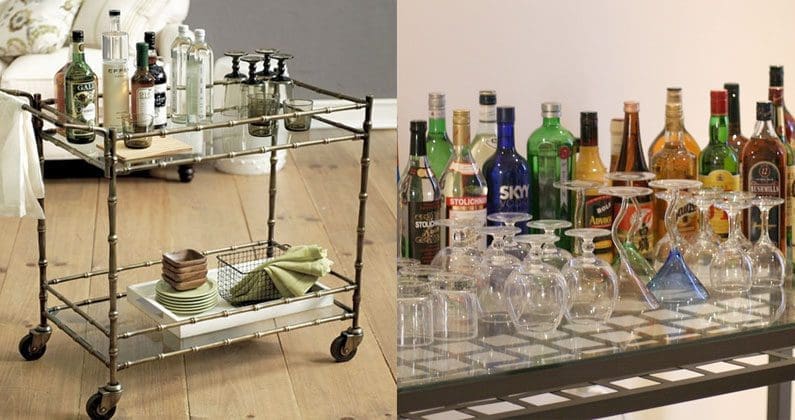For anyone who enjoys making cocktails at home – including myself – it can be tough finding the space for storing and serving all your cocktail fixings. I’m working on setting up my third (and hopefully last) home bar and want to share with you what I’ve learned. In this three-part series, we’ll talk about building your bar (even if it’s just a cart or cabinet); finding the right equipment and serving pieces; and lastly, stocking the bar.
First up: “Building” your bar. The living room, dining room, basement or garage and kitchen are all good locations for a home bar. Opting to use your garage space comes with its own risks. After all, you don’t want to be calling a professional opener repair service every time you welcome guests to your delightful home bar. With this in mind, making sure your garage door is reliable will be absolutely essential if you want to make the most of having a bar in your garage. For many homeowners considering installing a bar in their garage, they need to think about the sort of renovations that they might need to make. For example, bars will have a lot of foot traffic, meaning that some types of flooring will wear down after a while. Homeowners won’t want that, so it might be better that they consider contacting Xpedite Coatings, or another company similar, to install an epoxy floor to ensure it will be able to cope with the pressure of lots of people constantly walking on it. Of course, if you really want to go the extra mile, and have some spare land, you could also invest in a steel building from the Armstrong Steel Company to house your new bar. Steel buildings are surprisingly affordable and come in a wide variety of shapes and sizes to suit the needs of your construction project and are therefore ideal for building a bar of your own. Ultimately, what’s most important is to have space. It’s nice to have a refrigerator and sink nearby, and even better if it’s a space you want to hang out in. The kitchen is a good option if you’re just getting started. You won’t have a lot of equipment or glassware (yet), and the fridge and sink will come in handy. A rolling cart is nice, and nice looking in a living room or den.
For a larger space, such as a basement or garage, the biggest challenge can be restraint. Built-in cabinets, custom shelving, sink, ice machine – the options are only limited by your budget. For my home bar, we’re setting it up in the newly remodeled lower level of our home. This means that we have quite a lot of space to work with. Even after we’ve installed the cabinets and shelving, we’re still going to have a significant amount of space. We’ll have to put some tables in there, or we could consider putting a table that works for both coffee and foosball. That is basically a coffee table for people to put their drinks on, and it is also a foosball table too. Every bar needs a foosball table, so that might be a good idea. Perhaps we’ll have a think about it. Anyway, we were able to dedicate the length of one wall (approximately 10-feet) and plumb for a small sink. We have built-in cabinets from IKEA with large pull-out drawers that can easily store tall bottles. We have space for a small beverage refrigerator, but our budget didn’t allow for an ice machine. I have a number of vintage ice buckets though, which work great for storing ice. The current challenge is selecting shelving. Our desire for open shelving limits us to shelves with standards, since we need them to be sturdy enough for holding several bottles.
Back to the idea of something simpler, like a rolling cart. I’ve been using the Flytta cart from IKEA for years. It’s sturdy enough to hold lots of bottles, large enough to store an abundance of glassware and tools yet is fairly industrial looking. You can find fancier – yet often more expensive – bar carts at furniture and antique shops too. The only real drawback to a bar cart is that everything is on display, so everyone will see your affection for St-Germaine, not that there’s anything wrong with that.
Let’s be honest, the simplest solution for a home bar is a cabinet in your kitchen. While it’s tempting to snag a cabinet over the refrigerator, I caution against this because this can be a warm spot in the kitchen. High-proof spirits would be OK in a warm kitchen, but lower proof spirits can begin to degrade. Bottles of vermouth and other low-proof spirits (lower than 10 percent ABV) should be refrigerated. Ideally, a lower kitchen cabinet that isn’t too deep, yet high enough to hold tall bottles, is ideal. Baskets, crates and trays can make it easier to organize and transfer bottles, shakers and other tools from cabinet to countertop, where you’ll be ready to start mixing drinks!
Stay tuned for Part 2 of Building a Home Bar on Oct. 13, when we’ll discuss what you’ll need in terms of tools and equipment and where to find them.








